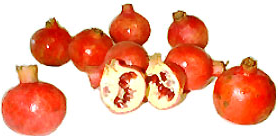


Lady Pomegranates
Estimated Inventory, 20 lbs : 0
Description/Taste
Resembling a Christmas tree ornament, beautiful Lady pomegranate fruit is a smaller version of the larger variety.
Seasons/Availability
A classic Christmas fruit for holiday centerpieces, look for pomegranates late August through December with a peak season in October and November.
Nutritional Value
Very low in sodium and fat, this fruit is an excellent source of fiber if the seeds are consumed. Pomegranates provide some potassium and vitamin C.
Applications
Pomegranates are most commonly used for their seeds and juice. After separating the seeds from the white pulp of the pomegranate, add to grain or green salads, or mix into sweetened yogurt. Bake seeds into a crisp with fall fruits such as apples or pears. Pomegranate juice can be used to marinate lamb or beef, or reduced into syrup and added to cocktails and smoothies. Cook juice, with sugar, into jam or add to milk or cream and freeze into sorbet and gelato. Pomegranates keep well stored at room temperature for 1-2 weeks.
Geography/History
Native from Iran to the Himalayas in northern India, the small tree that bears this fruit has been cultivated for its fruit in warm regions throughout the world. Known by botanists as "Punica granatum", this name that has an interesting origin. Reaching the Romans via Carthage in North Africa, they called it "mala punica", meaning Carthaginian apple. This explains its generic "Punica" name. The species name "granatum" is the Spanish "granada". The name pomegranate refers to the many seeds or "grains" inside this gorgeous fruit. Spanish settlers introduced pomegranate trees into California in the late 1700s. This fruit is now grown domestically, primarily in the driest parts of California and Arizona. The San Joaquin Valley in California is a very serious growing area. Pomegranates also thrive in Spain, Italy, Central and South America and the Middle East.
Recipe Ideas
Recipes that include Lady Pomegranates. One




